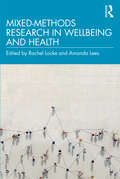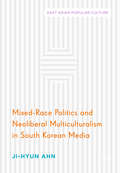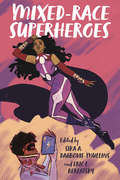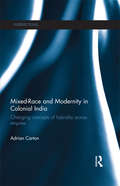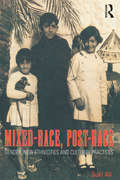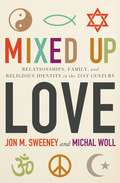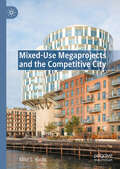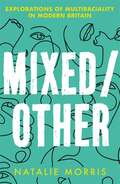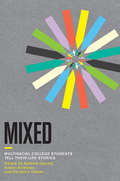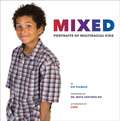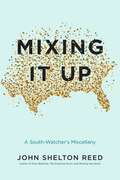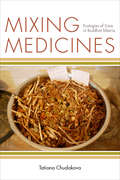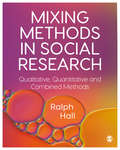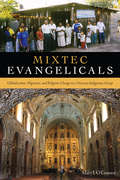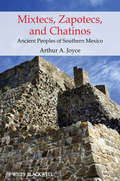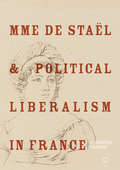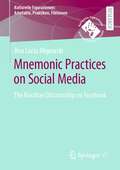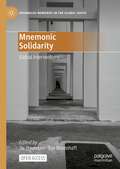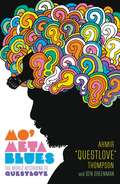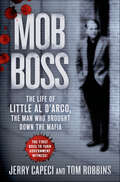- Table View
- List View
Mixed-Methods Research in Wellbeing and Health
by Rachel Locke Amanda LeesMixed-Methods Research in Wellbeing and Health brings together nine examples of high-quality research into wellbeing and health using a range of mixed methods. Research that employs mixed methods can yield robust data that is both more reliable and valid than that arising from a single-method approach. Mixed-methods research is a vital component in responding to recent changes to the more complex needs of an increasingly diverse society and its health sector. This book covers how mixed-methods research can be designed creatively and applied sensitively in the context of wellbeing and health research. The editors have included a set of bespoke questions for reflection at the end of each chapter. The expert editorial commentary highlights the benefits and methodological challenges of mixed-methods research as well as ‘thinking points’ for researchers as they plan and carry out mixed-methods research on wellbeing and health topics. Within a holistic view of wellbeing and health, the mixed-methods research designs are applied appropriately in both practice and community settings. The research can be shaped by pragmatism and the actual needs of a study rather than purely theoretical considerations. This practical book makes high-quality, mixed-methods research design and execution guidance readily accessible to health-care practitioners and researchers working in the fields of health, social care and wellbeing services and to undergraduate and postgraduate students in courses in research and health-care studies, as well as health management.
Mixed-Race Politics and Neoliberal Multiculturalism in South Korean Media
by Ji-Hyun AhnThis book studies how the increase of visual representation of mixed-race Koreans formulates a particular racial project in contemporary South Korean media. It explores the moments of ruptures and disjuncture that biracial bodies bring to the formation of neoliberal multiculturalism, a South Korean national racial project that re-aligns racial lines under the nation's neoliberal transformation. Specifically, Ji-Hyun Ahn examines four televised racial moments that demonstrate particular aspects of neoliberal multiculturalism by demanding distinct ways of re-imagining what it means to be Korean in the contemporary era of globalization. Taking a critical media/cultural studies approach, Ahn engages with materials from archives, the popular press, policy documents, television commercials, and television programs as an inter-textual network that actively negotiates and formulates a new racialized national identity. In doing so, the book provides a rich analysis of the ongoing struggle over racial reconfiguration in South Korean popular media, advancing an emerging scholarly discussion on race as a leading factor of social change in South Korea.
Mixed-Race Superheroes
by Gregory T. Carter Isabel Molina-Guzman Chris Gavaler Jasmine Mitchell Eric L. Berlatsky Chris Koenig-Woodyard Nicholas E. Miller Jorge J. Santos Kwasu David Tembo Sika A. Dagbovie-Mullins Corrine Esther Collins Adrienne ReshaAmerican culture has long represented mixed-race identity in paradoxical terms. On the one hand, it has been associated with weakness, abnormality, impurity, transgression, shame, and various pathologies; however, it can also connote genetic superiority, exceptional beauty, and special potentiality. This ambivalence has found its way into superhero media, which runs the gamut from Ant-Man and the Wasp’s tragic mulatta villain Ghost to the cinematic depiction of Aquaman as a heroic “half-breed.” The essays in this collection contend with the multitude of ways that racial mixedness has been presented in superhero comics, films, television, and literature. They explore how superhero media positions mixed-race characters within a genre that has historically privileged racial purity and propagated images of white supremacy. The book considers such iconic heroes as Superman, Spider-Man, and The Hulk, alongside such lesser-studied characters as Valkyrie, Dr. Fate, and Steven Universe. Examining both literal and symbolic representations of racial mixing, this study interrogates how we might challenge and rewrite stereotypical narratives about mixed-race identity, both in superhero media and beyond.
Mixed-Race Superman: Keanu, Obama, and Multiracial Experience
by Will HarrisAn edgy and insightful look at Barack Obama, Keanu Reeves, and the mixed-race experience in our divided world.At once personally revealing and politically astute, author Will Harris reflects on the lives of two very different supermen: Barack Obama and Keanu Reeves. In an era where a man endorsed by the Ku Klux Klan can sit in the White House, Harris argues that the mixed-race of both Obama and Reeves gave them a cultural shapelessness that was a form of resistance. Reeves, as Neo in The Matrix, portrayed the chosen one on the silver screen, while Obama, for a brief moment, was a real-life superhero on the world stage.Drawing on his own personal experience and examining the way that these two men have been embedded in our collective consciousness, Harris asks what they can teach us about race and heroism.
Mixed-Race and Modernity in Colonial India: Changing Concepts of Hybridity Across Empires (Intersections: Colonial and Postcolonial Histories)
by Adrian CartonFocusing on Portuguese, British and French colonial spaces, this book traces changing concepts of mixed-race identity in early colonial India. Starting in the sixteenth century, it discusses how the emergence of race was always shaped by affiliations based on religion, class, national identity, gender and citizenship across empires. In the context of increasing British power, the book looks at the Anglo-French tensions of the eighteenth century to consider the relationship between modernity and race-making. Arguing that different forms of modernity produced divergent categories of hybridity, it considers the impact of changing political structures on mixed-race communities. With its emphasis on specificity, the book situates current and past debates on the mixed-race experience and the politics of whiteness in broader historical and global contexts. By contributing to the understanding of race-making as an aspect of colonial governance, the book illuminates some margins of colonial India that are often lost in the shadows of the British regime. It is of interest to academics of world history, postcolonial studies, South Asian imperial history and critical mixed-race studies.
Mixed-Race, Post-Race: Gender, New Ethnicities and Cultural Practices
by Suki AliSocial scientists claim that we now live in a post-race society, where race has been replaced by 'ethnicity'. Yet racism is endemic to British society and people often think in terms of black and white. With a marked rise in the number of children from mixed parentage, there is an urgent need to challenge simplistic understandings of 'race', nation and culture, and interrogate what it means to grow up in Britain and claim a 'mixed' identity. Focusing on mixed-race and inter-ethnic families, this book not only explores current understandings of 'race', but it shows, using innovative research techniques with children, how we come to read race. What influence do photographs and television have on childrens ideas about 'race'? How do children use memories and stories to talk about racial differences within their own families? How important is the home and domestic culture in achieving a sense of belonging? Ali also considers, through data gathered from teachers and parents, broader issues relating to the effectiveness of anti-racist and multicultural teaching in schools, and parental concerns over the social mobility and social acceptability of their children. Rigorously researched, this book is the first to combine childrens accounts on 'race' and identity with contemporary cultural theory. Using fascinating case studies, it fills a major gap in this area and provides an original approach to writing on race.
Mixed-Up Love: Relationships, Family, and Religious Identity in the 21st Century
by Jon M. Sweeney Michal WollDating, commitment, kids, and family--it's all hard work, and when you come from different religious backgrounds it's even harder. Jon, a Catholic writer, and Michal, a Reconstructionist rabbi, live out the challenges of an interfaith relationship everyday as husband and wife, and as parents to their daughter Sima, who is being raised Jewish. In MIXED-UP LOVE, the couple explores how interfaith relationships impact dating, weddings, holidays, raising children, and family functions--and how to not just cope, but thrive. This is an engaging and practical resource for singles who are considering dating outside their own faith, couples in interfaith relationships, relatives and friends of "mixed" couples who seek information and understanding, and parents desiring a fresh perspective. With clarity, insight, and humor, Sweeney and Woll demonstrate how to engage with your partner, family, and faith like never before. es and the lives of millions of others, and what it can mean for a more spiritually engaged future.
Mixed-Use Megaprojects and the Competitive City
by Mike S. HarrisThis book examines the motives and outcomes of competitively positioned mixed-use megaprojects on government-owned land. These projects have emerged worldwide in recent decades, driven by urban international competition, the mobility and expansion of knowledge economies, the shift of global investment from physical to human capital, and the prevalence of market-driven or entrepreneurial politics. Six case studies across three countries are analysed through five themes: Positioning, Governing, Shaping, Connecting, and Public Benefit. While pursuing similar objectives of attracting mobile capital, each project operates within a specific political, financial and social context. These projects reflect the prevailing development practices and underlying power structures of cities and states. Throughout the implementation process, they can also reveal the power struggles and competing agendas within a city. In this manner, they serve as a valuable lens for understanding the political, economic, and cultural dynamics of a city, and how urban morphology manifests these processes.
Mixed/Other: Explorations of Multiraciality in Modern Britain
by Natalie MorrisHow does it feel when your heritage isn't listed as an option on an identification form?What is it like to grow up as the only person in your family who looks like you?Where do you belong if you are simultaneously seen as being 'too much' of one race and 'not enough' of another to fit neatly into society's expectations?The mixed population is the fastest-growing group in the U.K. today, but the mainstream conversation around mixedness is stilted, repetitive and often problematic. At a time when ethnically ambiguous models fill our Instagram feeds and our high street shop windows, and when children of interracial relationships are lauded as heralding in the dawn of a post-racial utopia, journalist Natalie Morris takes a deep dive into what it really means to be mixed in Britain today. From blackfishing to the fetishisation of mixed babies; from the complexities of passing and code-switching to navigating the world of work and dating, Natalie explores the ways in which all of these issues uniquely impact those of mixed heritage. Drawing from a wealth of research, interviews and her own personal experiences, in Mixed/Other, Natalie's aims to dismantle the stereotypes that have plagued mixed people for generations and to amplify the voices of mixed Britons today, shining a light on the struggles and the joys that come with being mixed.
Mixed: Multiracial College Students Tell Their Life Stories
by Andrew Garrod Robert Kilkenny Christina GómezMixed presents engaging and incisive first-person experiences of what it is like to be multiracial in what is supposedly a postracial world. Bringing together twelve essays by college students who identify themselves as multiracial, this book considers what this identity means in a reality that occasionally resembles the post-racial dream of some and at other times recalls a familiar world of racial and ethnic prejudice. Exploring a wide range of concerns and anxieties, aspirations and ambitions, these young writers, who all attended Dartmouth College, come from a variety of racial, ethnic, and socioeconomic backgrounds. Unlike individuals who define themselves as having one racial identity, these students have lived the complexity of their identity from a very young age. In Mixed, a book that will benefit educators, students, and their families, they eloquently and often passionately reveal how they experience their multiracial identity, how their parents' race or ethnicity shaped their childhoods, and how perceptions of their race have affected their relationships.
Mixed: Portraits of Multiracial Kids
by Kip FulbeckFrom beloved writer and artist Kip Fulbeck, author of Part Asian, 100% Hapa, this timely collection of portraits celebrates the faces and voices of mixed-race children. At a time when 7 million people in the U.S. alone identify as belonging to more than one race, interest in issues of multiracial identity is rapidly growing. Overflowing with uplifting elements--including charming images, handwritten statements from the children, first-person text from their parents, a foreword by Dr. Maya Soetoro-Ng (President Obama's sister), and an afterword by international star Cher (who is part Cherokee)--this volume is an inspiring vision of the future.
Mixing It Up: A South-Watcher's Miscellany
by John Shelton ReedToo often depicted as a region with a single, dominant history and a static culture, the American South actually comprises a wide range of unique places and cultures, each with its own history and evolving identity. John Shelton Reed’s Mixing It Up is a medley of writings that examine how ideas of the South, and what it means to be southern, have changed over the last century. Through essays, op-eds, speeches, statistical reports, elegies, panegyrics, feuilletons, rants, and more, Reed’s penetrating observations, wry humor, and expansive knowledge help him to examine the South’s past, survey its present, and venture a few modest predictions about its future. Touching on an array of topics from the region’s speech, manners, and food, to politics, religion, and race relations, Reed also assesses the work of other pundits, scholars, and South-watchers.From Appalachia to New Orleans, Mixing it Up: A South-Watcher’s Miscellany offers a collection of lively prose and provocative observations about this ever-changing region and its people.
Mixing It Up: Multiracial Subjects
by Sansan Kwan Kenneth SpeirsThe United States Census 2000 presents a twenty-first century America in which mixed-race marriages, cross-race adoption, and multiracial families in general are challenging the ethnic definitions by which the nation has historically categorized its population. Addressing a wide spectrum of questions raised by this rich new cultural landscape, Mixing It Up brings together the observations of ten noted voices who have experienced multiracialism first-hand.<P><P>From Naomi Zack's "American Mixed Race: The United States 2000 Census and Related Issues" to Cathy Irwin and Sean Metzger's "Keeping Up Appearances: Ethnic Alien-Nation in Female Solo Performance," this diverse collection spans the realities of multiculturalism in compelling new analysis. Arguing that society's discomfort with multiracialism has been institutionalized throughout history, whether through the "one drop" rule or media depictions, SanSan Kwan and Kenneth Speirs reflect on the means by which the monoracial lens is slowly being replaced.
Mixing Medicines: Ecologies of Care in Buddhist Siberia (Thinking from Elsewhere)
by Tatiana ChudakovaTraditional medicine enjoys widespread appeal in today’s Russia, an appeal that has often been framed either as a holdover from pre-Soviet times or as the symptom of capitalist growing pains and vanishing Soviet modes of life. Mixing Medicines seeks to reconsider these logics of emptiness and replenishment. Set in Buryatia, a semi-autonomous indigenous republic in Southeastern Siberia, the book offers an ethnography of the institutionalization of Tibetan medicine, a botanically-based therapeutic practice framed as at once foreign, international, and local to Russia’s Buddhist regions.By highlighting the cosmopolitan nature of Tibetan medicine and the culturally specific origins of biomedicine, the book shows how people in Buryatia trouble entrenched center-periphery models, complicating narratives about isolation and political marginality. Chudakova argues that a therapeutic life mediated through the practices of traditional medicines is not a last-resort response to sociopolitical abandonment but depends on a densely collective mingling of human and non-human worlds that produces new senses of rootedness, while reshaping regional and national conversations about care, history, and belonging.
Mixing Methods in Social Research: Qualitative, Quantitative and Combined Methods
by Dr. Ralph P. HallThis book provides a straightforward, student-focused introduction to doing mixed methods research, covering everything from why and when mixed methods is appropriate, as well as how to use qualitative and quantitative methods in tandem. Assuming no prior research methods knowledge, it introduces mixed methods alongside basic research theory and principles, fully integrating mixed methods into the research methods foundation. With clearly defined key terms and a structure that maps to the way students work on their projects, it progresses at a gradual pace suitable for mixed methods beginners. Offering encouragement and tips for success throughout the full research process, Hall helps students confidently: - Explain mixed methods paradigms and methodologies - Define and choose a research approach - Combine methods effectively - Sample, collect, and analyze primary and secondary data - Communicate and write up results. Packed with tables, figures, and boxes that distill key concepts into retainable visuals, this book is the perfect companion to support students on their mixed methods projects.
Mixing Methods in Social Research: Qualitative, Quantitative and Combined Methods
by Dr. Ralph P. HallThis book provides a straightforward, student-focused introduction to doing mixed methods research, covering everything from why and when mixed methods is appropriate, as well as how to use qualitative and quantitative methods in tandem. Assuming no prior research methods knowledge, it introduces mixed methods alongside basic research theory and principles, fully integrating mixed methods into the research methods foundation. With clearly defined key terms and a structure that maps to the way students work on their projects, it progresses at a gradual pace suitable for mixed methods beginners. Offering encouragement and tips for success throughout the full research process, Hall helps students confidently: - Explain mixed methods paradigms and methodologies - Define and choose a research approach - Combine methods effectively - Sample, collect, and analyze primary and secondary data - Communicate and write up results. Packed with tables, figures, and boxes that distill key concepts into retainable visuals, this book is the perfect companion to support students on their mixed methods projects.
Mixing Races: From Scientific Racism to Modern Evolutionary Ideas (Johns Hopkins Introductory Studies in the History of Science)
by Paul Lawrence FarberThis book explores changing American views of race mixing in the twentieth century, showing how new scientific ideas transformed accepted notions of race and how those ideas played out on college campuses in the 1960s.In the 1930s it was not unusual for medical experts to caution against miscegenation, or race mixing, espousing the common opinion that it would produce biologically dysfunctional offspring. By the 1960s the scientific community roundly refuted this theory. Paul Lawrence Farber traces this revolutionary shift in scientific thought, explaining how developments in modern population biology, genetics, and anthropology proved that opposition to race mixing was a social prejudice with no justification in scientific knowledge.In the 1960s, this new knowledge helped to change attitudes toward race and discrimination, especially among college students. Their embrace of social integration caused tension on campuses across the country. Students rebelled against administrative interference in their private lives, and university regulations against interracial dating became a flashpoint in the campus revolts that revolutionized American educational institutions. Farber’s provocative study is a personal one, featuring interviews with mixed-race couples and stories from the author’s student years at the University of Pittsburgh. As such, Mixing Races offers a unique perspective on how contentious debates taking place on college campuses reflected radical shifts in race relations in the larger society.
Mixing Races: From Scientific Racism to Modern Evolutionary Ideas (Johns Hopkins Introductory Studies in the History of Science)
by Paul Lawrence Farber“Traces both historically and sociologically the changing attitudes on race-mixing (miscegenation) in western culture . . . clear, well written and useful.” —Journal of the History of BiologyThis book explores changing American views of race mixing in the twentieth century, showing how new scientific ideas transformed accepted notions of race and how those ideas played out on college campuses in the 1960s.In the 1930s it was not unusual for medical experts to caution against miscegenation, or race mixing, espousing the common opinion that it would produce biologically dysfunctional offspring. By the 1960s the scientific community roundly refuted this theory. Paul Lawrence Farber traces this revolutionary shift in scientific thought, explaining how developments in modern population biology, genetics, and anthropology proved that opposition to race mixing was a social prejudice with no justification in scientific knowledge.In the 1960s, this new knowledge helped to change attitudes toward race and discrimination, especially among college students. Their embrace of social integration caused tension on campuses across the country. Students rebelled against administrative interference in their private lives, and university regulations against interracial dating became a flashpoint in the campus revolts that revolutionized American educational institutions.Farber’s provocative study is a personal one, featuring interviews with mixed-race couples and stories from the author’s student years at the University of Pittsburgh. As such, Mixing Races offers a unique perspective on how contentious debates taking place on college campuses reflected radical shifts in race relations in the larger society.“A fascinating look at how evolutionary science has changed alongside social beliefs.” —Midwest Book Review“Will open the dialogue about social barriers and group identities . . . Essential.” —Choice
Mixtec Evangelicals: Globalization, Migration, and Religious Change in a Oaxacan Indigenous Group
by Mary I. O'ConnorMixtec Evangelicals is a comparative ethnography of four Mixtec communities in Oaxaca, detailing the process by which economic migration and religious conversion combine to change the social and cultural makeup of predominantly folk-Catholic communities. The book describes the effects on the home communities of the Mixtecs who travel to northern Mexico and the United States in search of wage labor and return having converted from their rural Catholic roots to Evangelical Protestant religions. O’Connor identifies globalization as the root cause of this process. She demonstrates the ways that neoliberal policies have forced Mixtecs to migrate and how migration provides the contexts for conversion. Converts challenge the set of customs governing their Mixtec villages by refusing to participate in the Catholic ceremonies and social gatherings that are at the center of traditional village life. The home communities have responded in a number of ways—ranging from expulsion of converts to partial acceptance and adjustments within the village—depending on the circumstances of conversion and number of converts returning. Presenting data and case studies resulting from O’Connor’s ethnographic field research in Oaxaca and various migrant settlements in Mexico and the United States, Mixtec Evangelicals explores this phenomenon of globalization and observes how ancient communities are changed by their own emissaries to the outside world. Students and scholars of anthropology, Latin American studies, and religion will find much in this book to inform their understanding of globalization, modernity, indigeneity, and religious change.
Mixtecs, Zapotecs, and Chatinos
by Arthur A. JoyceMixtecs, Zapotecs, and Chatinos: Ancient Peoples of Southern Mexico examines the origins, history, and interrelationships of the civilizations that arose and flourished in Oaxaca. Provides an up-to-date summary of the current state of research findings and archaeological evidenceUses contemporary social theory to address many key problems relating to archaeology of the Americas, including the dynamics of social life and the rise and fall of civilizationsAdds clarity to ongoing debates over cultural change and interregional interactions in ancient Mesoamerican societiesSupplemented with compelling illustrations, photographs, and line drawings of various archaeological sites and artifacts
Mme de Staël and Political Liberalism in France
by Chinatsu TakedaThis book sheds light on the unique aspects of ‘communal liberalism’ in Mme de Staël’s writings and considers her contribution to nineteenth-century French liberal political thought. Focusing notably on the ‘Considérations sur les principaux événements de la Révolution française’, it examines the originality of Stael’s liberal philosophy. Rather than contrasting liberalism with either multiculturalism or republicanism, the book argues that Staël’s communal liberalism challenges the conventions of nineteenth-century political thought, notably through her assertion of the need to institutionalize an organic intermediary connecting the two spheres, an idea later advanced by thinkers such as Jürgen Habermas. Offering a critical reappraisal of Staël’s multifaceted work, this book assesses the political impact of her work, arguing that the political influence of the ‘Considérations’ permeates the liberal historiography of the French Revolution up to the present day.
Mnemonic Practices on Social Media: The Brazilian Dictatorship on Facebook (Kulturelle Figurationen: Artefakte, Praktiken, Fiktionen)
by Ana Lúcia Migowski da SilvaThis book reflects on discourses about the Brazilian dictatorship (1964-1985) on social media. It examines entanglements between technological and mnemonic practices regarding this historical period. Following Olick and Robbins’ (1998) Historical Sociology of Mnemonic Practices, the book analyses more than what social actors say about the past. It explores the externalisation of knowledge about the past based on interactions identified on Facebook. Through this platform, it was possible to map and collect posts, comments, and reactions related to the historical period. This sample reveals perceptions and attitudes of social media users toward the past. The book also discusses socio-technical matters grounding mnemonic practices observed on Facebook. The concept of mnemonic affordance served as a conceptual tool for understanding situational elements involved in what users perceive that they can do on Facebook while articulating meanings about the past. The close analysis of two affordances indicates specificities in the performance of mnemonic practices on Facebook. These issues shed light on struggles for legitimacy regarding memories of the dictatorship and their impact on traditional regimes of knowledge and current public affairs in Brazil.
Mnemonic Solidarity: Global Interventions (Entangled Memories in the Global South)
by Eve Rosenhaft Jie-Hyun LimThis open access book provides a concise introduction to a critical development in memory studies. A global memory formation has emerged since the 1990s, in which memories of traumatic histories in different parts of the world, often articulated in the terms established by Holocaust memory, have become entangled, reconciled, contested, conflicted and negotiated across borders. As historical actors and events across time and space become connected in new ways, new grounds for contest and competition arise; claims to the past that appeared de-territorialized in the global memory formation become re-territorialized – deployed in the service of nationalist projects. This poses challenges to scholarship but also to practice: How can we ensure that shared or comparable memories of past injustice continue to be grounds for solidarity between different memory communities? In chapters focusing on Europe, East Asia and Africa, five scholars respond to these challenges from a range of disciplinary perspectives in the humanities.
Mo' Meta Blues: The World According to Questlove
by Ben Greenman Ahmir Questlove" Thompson"You have to bear in mind that [Questlove] is one of the smartest motherfuckers on the planet. His musical knowledge, for all practical purposes, is limitless." --Robert ChristgauMO' META BLUESThe World According to QuestloveMo' Meta Blues is a punch-drunk memoir in which Everyone's Favorite Questlove tells his own story while tackling some of the lates, the greats, the fakes, the philosophers, the heavyweights, and the true originals of the music world. He digs deep into the album cuts of his life and unearths some pivotal moments in black art, hip hop, and pop culture. Ahmir "Questlove" Thompson is many things: virtuoso drummer, producer, arranger, Late Night with Jimmy Fallon bandleader, DJ, composer, and tireless Tweeter. He is one of our most ubiquitous cultural tastemakers, and in this, his first book, he reveals his own formative experiences--from growing up in 1970s West Philly as the son of a 1950s doo-wop singer, to finding his own way through the music world and ultimately co-founding and rising up with the Roots, a.k.a., the last hip hop band on Earth. Mo' Meta Blues also has some (many) random (or not) musings about the state of hip hop, the state of music criticism, the state of statements, as well as a plethora of run-ins with celebrities, idols, and fellow artists, from Stevie Wonder to KISS to D'Angelo to Jay-Z to Dave Chappelle to...you ever seen Prince roller-skate?!? But Mo' Meta Blues isn't just a memoir. It's a dialogue about the nature of memory and the idea of a post-modern black man saddled with some post-modern blues. It's a book that questions what a book like Mo' Meta Blues really is. It's the side wind of a one-of-a-kind mind. It's a rare gift that gives as well as takes. It's a record that keeps going around and around.
Mob Boss: The Life of Little Al D'Arco, the Man Who Brought Down the Mafia
by Tom Robbins Jerry Capeci“[A] fascinating new book about mafia boss Alfonso D’Arco, who became the federal government’s most successful cooperator.” —The Village VoiceAlfonso “Little Al” D’Arco, the former acting boss of the Luchese organized crime family, was the highest-ranking mobster to ever turn government witness when he flipped in 1991. His decision to flip prompted many others to make the same choice, including John Gotti’s top aide, Salvatore “Sammy the Bull” Gravano, and his testimony sent more than fifty mobsters to prison.In Mob Boss, award-winning news reporters Jerry Capeci and Tom Robbins team up for this unparalleled account of D’Arco’s life and the New York mob scene that he embraced for four decades.Until the day he switched sides, D’Arco lived and breathed the old-school gangster lessons he learned growing up in Brooklyn and fine-tuned on the mean streets of Little Italy. But when he learned he was marked to be whacked, D’Arco quit the mob. His defection decimated his crime family and opened a window on mob secrets going back a hundred years.After speaking with D’Arco, the authors reveal unprecedented insights, exposing shocking secrets and troublesome truths about a city where a famous pizza parlor doubled as a Mafia center for multi-million-dollar heroin deals, where hit men carried out murders dressed as women, and where kidnapping a celebrity newsman’s son was deemed appropriate revenge for the father’s satirical novel.Capeci and Robbins spent hundreds of hours in conversation with D’Arco, and exhausted many hours more fleshing out his stories in this riveting narrative that takes readers behind the famous witness testimony for a comprehensive look at the Mafia in New York City.
